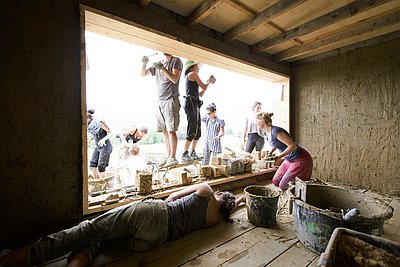BASEhabitat at the University of Art and Design Linz celebrates its 20th birthday
Event program in March and April 2024
The renowned course of the architecture department at the University of Art and Design Linz, which is dedicated to sustainable and socially responsible construction, is celebrating its 20th anniversary this year - with a varied program for the interested public.
Twenty years ago, the architecture department of the University of Art and Design Linz created a therapy center for children with special needs in South Africa. The project in the south-west of Johannesburg not only resulted in a safe place made of clay, wood, straw and grass mats for the children, but also in BASEhabitat, a studio of its own that is still involved in sustainable construction and socially responsible architecture and has already realized dozens of such projects around the world with students from the University of Art and Design Linz.
At the beginning of the year, Rector Brigitte Hütter once again signed up to the UNESCO Chair for "Earthen Architectures, building cultures and sustainable development". The UNESCO initiative now has a total of 34 partner institutions in 22 countries, including university institutions such as BASEhabitat, research centers, but also various NGOs in Africa, America, Asia and Europe. With Martin Rauch, a pioneer in rammed earth and honorary professor of the UNESCO Earthen Architecture Chair, and Anna Heringer, a globally successful architect and graduate of the architecture department, two experts from the BASEhabitat network are also represented as honorary members of the UNESCO Chair, which researches and promotes earthen construction.
But how do you create sustainable architecture in times of constantly advancing climate change? Professor Sigi Atteneder, Head of Architecture at the University of Art and Design Linz: "One of the principles of our curriculum is that students put their plans into practice directly on construction sites. Because abstract planning on the computer alone makes it difficult to ground your plans". The basic idea of BASEhabitat is also "to reduce the CO2 emissions of building construction and to use alternative building materials such as clay, earth and wood instead of concrete and cement". In addition to all this, it is also important to "guarantee sustainable spatial planning and mobility". This means that BASEhabitat focuses not only on sustainable raw materials, "but also on taking local conditions, cultural characteristics and inclusive planning and construction processes into account. Careful handling of existing buildings is also essential for BASEhabitat - and therefore a culture of conversion and extension."
Rector Brigitte Hütter congratulates on the anniversary: "We are delighted for BASEhabitat, our renowned architecture course, to be a partner in the UNESCO Chair for 'Earthen Architecture' and thus to promote the exchange of content and international networking of architects and all those interested in social and ecological planning and building. BASEhabitat's central concerns are careful analysis, high-quality designs and implementation with one's own hands. Congratulations on 20 years of sustainable design in various countries around the world!"
In general, architecture students with a Bachelor's degree at the University of Art and Design Linz can do a Master's in Architecture | BASEhabitat, while the international postgraduate BASEhabitat course is aimed at architecture graduates.
To mark the 20th anniversary of BASEhabitat, the studio of the architecture department is offering a varied program for the interested public - an excerpt:
Anniversary program
On Monday, March 4 , 2024 at 5 p.m., the material exhibition "Building Futures" will open in the atrium of the University of Art and Design Linz on Hauptplatz 6, presenting the range of regenerative materials and their possible uses in architecture. Questions such as: Can clay be processed using a 3D printer? How does a roof structure with reeds work? And how does wool become an insulating material? Open until Friday, March 22, 2024.
As part of a guest lecture Towards an insurgent urbanism at the University of Art and Design Linz on March 6, 2024 at 5 p. m., Juliana Canedo from the Technical University of Berlin will speak about collaborative design methods and the inclusion of marginalized groups in Berlin and Rio de Janeiro. Passive house pioneer Helmut Krapmeier and Jan Müller from the University of Wuppertal will discuss circular construction on March 15, 2024 at 10.00 a.m. and present examples from the Solar Decathlon Europe, the largest student competition for sustainable building.
At the OPEN DAY of the University of Art and Design Linz on Wednesday, March 20, BASEhabitat will offer visitors the opportunity to work and experiment with clay and provide information about the study program - from 9 a.m. to 5 p.m.
On April 9, 2024, from 10:00 to 12:00, the guest lecture "Carbon Footprint Analysis of a BASEhabitat Building" by Vorasiri de Cadenet (SUT Thailand) will take place in the Sofahörsaal of the University of Art and Design Linz, Hauptplatz 6, 4th floor.
As part of the three-day "New European Bauhaus Festival", in which the City of Linz, the Ars Electronica Center and the Tabakfabrik are also participating, BASEhabitat will be exhibiting various projects on sustainable architecture on Friday, April 19. A big celebration to mark its 20th anniversary will then be held in the fall.
Architecture Days June 7-8, 2024
Reuse of building components using the example of the LenA project, Stadl-Paura
Bioregional Assembly - Salzkammergut Capital of Culture
Circular building with clay and waste materials in Gmunden
July - September 2024

